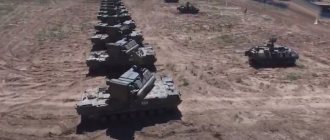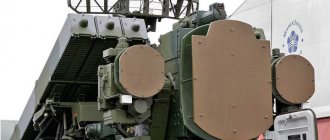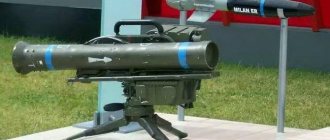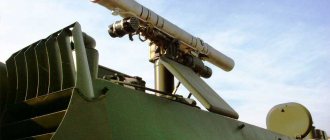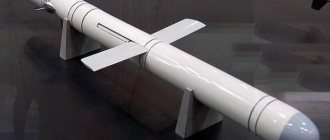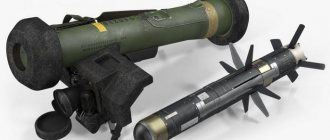With the development of air-military technology, the need arose to arm the ground forces and protect personnel from a sudden enemy attack from the air. For this purpose, the Russian army began to adopt short-range anti-aircraft missile systems. Their main purpose is to protect units from attack by enemy aircraft in all types of combat, as well as on the march.
Now the main defense of the Russian ground army is the Strela-10M3 complex. But soon it is planned to introduce the new Sosna short-range air defense system into military units. During tests in 2016, it showed significant superiority over other types of equipment.
Development history
The idea to create a lightweight anti-aircraft missile system, which is Sosna, appeared back in 1990. A. G. Shipunov, a member of the Russian Academy of Sciences, proposed to design a lightweight version of the technology based on the Strela-10 air defense system by introducing a laser missile guidance system and an optical-electronic control system.
The development of a new air defense system model began in 2005 and is still ongoing. The sample was first presented to the public in 2013 at a conference dedicated to the development of air defense technology in the city of Smolensk. At the same time, the first tests were carried out. It is expected that after final tests in 2022, the Sosna air defense system will be approved and put into service.
Foggy future
From what is described above, it becomes clear that the wheeled version of the Sosna-type air defense system seems to be an extremely interesting and promising project. Its key positive quality is the excellent combination of an advanced armored platform and a unified rifle module. This technique differs in many ways from other improvements of this type of air defense system, which allows for improved tactical and technical characteristics, and also carries considerable commercial opportunities.
But this does not make the future of the Sosna air defense system, based on the BTR-82A platform, more specific and definite. The development of the project was carried out quite recently and the prototype had not yet completed all the testing stages. In addition, potential foreign customers were also unable to familiarize themselves and study the latest modification of the air defense system in more detail in order to make any serious decisions about orders.
In any case, a wide range of applications for ready-made units will be very useful in this technology development scenario. Due to this, the speed of testing and calibration of guns will be reduced, after which it will be possible to accept the first orders for mass production. But even then, the fate of the wheeled version of the Sosna will entirely depend on the opinion of the Russian Ministry of Defense.
Goals and objectives of the complex
At the initial stages of development of the complex, the goal was to increase the combat potential of the Strela-10 air defense system and increase its endurance. In accordance with this, the basic design principles were formulated:
- introduction of the Sosna-10R anti-aircraft guided missile into the base of the complex;
- creation of a new missile defense control system, tele-oriented in a laser beam;
- introduction of a multi-channel optical-electronic weapons control system with automatic control, protected from electronic interference and capable of operating around the clock, in almost any weather;
- creation of automatic and semi-automatic fire guidance modes.
Among other things, the Sosna air defense missile system was supposed to become more effective due to precise targeting, the use of several types of fuses (non-contact and contact laser with a circular diagram), as well as by reducing the flight time to the target by increasing the initial speed.
Links
Air Force and Air Defense Short range (10 to 50 km) S-25 "Berkut" • S-75 "Dvina" • S-125 "Neva"/"Pechora" Medium range (from 50 to 200 km) "Dal" • S-300P • S-300PT • S-300PS •
VityazLong range (> 200 km) S-200 • S-300PM • S-400 “Triumph/Triumfator” • S-500/S-1000 Memory of the Russian Ground Forces ZO ZU-23-2 • S-60 • KS-19 • KS-30 • KM-52 ZSU ZSU-23-4 Shilka • Object 530 •
ZSU-37-2 “Yenisei”
• ZSU-57-2 • 2K22 “Tunguska”SAM 9K31 “Strela-1” • 9K35 “Strela-10” • "MD-PS" •
"
Sosna " • 9K33 "Osa" • 9K330 "Thor"Short range (15 to 30 km) 2K12 "Cube" Medium range (from 30 to 100 km) 2K11 “Krug” • 9K37 “Buk” • 9K37M1 “Buk-M1” • 9K37M1-2 “Buk-M1-2” • 9K317 "Buk-M2" •
"Buk-M3"Long range (> 100 km) 9K81 S-300V “Antey-300” • 9K81M S-300VM “Antey-2500” ZU of the Russian Navy SAM "Strela-M" • 3M47 "Gibka" • M-4 "Osa-M" • 3K95 "Dagger/Blade" • Short range (15 to 40 km) M-1 "Volna" • M-2 "Volkhov-M" • M-11 "Storm" • M-22 "Hurricane" • 3S90E.1 "Calm-1" • "Tornado" Collective Defense (> 40 km) S-300F “Fort” • S-300FM “Fort-M” • “Redut” Command posts, controls, miscellaneous Ground Forces KSA "Barnaul-T" • UBKP "Rangir" • UBKP "Ranzhir-M" • "Senezh" • "Baikal-1" • KUZA-1 • 9S44 "Crab" K-1 • "Polyana-D1" • "Polyana- D4" • KP 9S470 (9K37 "Buk") • KP 9S457 (ZRS S-300V) Navy "Fort" * - produced only for export. Italic Promising, experimental, or samples that did not go into mass production were identified
T-44 · T-54 · T-55 · Object 416
·
Object 141
·
Object 139
·
Object 907
·
Object 140
·
Object 142
·
Object 430
·
Object 435
·
Object 167
· T-62 · T-62A ·
Object 920
· T-64
[/td]Medium tanks Heavy tanks IS-3 IS-4 IS-7 · T-10 ·
Object 266
·
Object 277
·
Object 278
·
Object 279
·
Object 770Missile tanks IT-1 · Item 64992 ·
Object 170
·
Object 431
·
Object 757
·
Object 772
·
Object 282
·
Object 906B
·
Object 775
·
Object 287
·
Object 780Flamethrower tanks OT-54 · Object 483 TO-55
BMPT Object 781 ·
Object 782
·
Object 787
· Object 199 "Frame"* ·
BMPT-72Main battle tanks T-62B · T-64A · T-64BV ·
Object 476
·
Object 172
·
Object 172-2M
· T-72 · T-72A · T-72B · T-72BA · T-72B3 · T-74 ·
T
-80 ·
T- 80A
·
Object 478
·
Object 785
·
Object 187
·
Object 477
·
Object 292
· T-80U · T-80UD · T-90 ·
T-90AM
·
Object 640
·
Object 195
·
T-14 (based on TSUP "Armata")ATGM combat vehicles 2P27 "Bumblebee" · 2P32 "Phalanx" · 9P19 "Eye" · 9P110 "Malyutka" · 9P122 "Malyutka-M" · 9P124 "Phalanga-M" · 9P133 "Malyutka-P" · 9P137 "Flute" · 9P148 "Konkurs" · 9P149 "Sturm-S" · 9P157 "Chrysanthemum-S" · 9P161 "Kornet-S" · 9P162 "Kornet-T"
Combat reconnaissance vehicles BRDM-1 Object 760 (“hover tank”) ·
BRDM-VPK
·
BRDM-VPS
·
Object 8M-906
· BRDM-2 · BRDM-3 · BRM-1K ·
BRM-2
· BRM-3K ·
BKM Airborne Forces "Vydra"
·
Patrol-AFlamethrower combat vehicles BMO-1 · BMO-T Armored personnel carriers K-75 · BTR-40 ·
BTR-112
·
K-78
· BTR-152 ·
ZIS-153
· BTR-50 ·
BTR-E152V
·
ZIL-153
·
GT-L
·
GT-LB
·
Object 1015
· BTR-60 · MT-
D
· BTR-70 · BTR-80 · BMM-80 · BTR-82 · BTR-90
·
BTR-T
· BTR-MD “Rakushka” ·
BMM-D
“ Boomerang " DT
-3PB
"
KrymskArmored vehicles Ural-4320-09-31 Ural-E4320D-31 Ural-E5323D GAZ-39344 ·
"Warrior"
·
"Bear"
·
Ural-6320
· "Typhoon" · ("Typhoon-U" ·
Ural-63099
· "Typhoon-K" ·
KAMAZ-63969
) · "Vodnik" · "Shot" · "Tiger" ·
"Wolf"
·
"Scorpion LTA"
·
"Bulat"
·
"Highlander-K"
·
"Federal-M" ("Stargazer")
·
"Scorpion LSA-B"ASU-76 ·
K-73
· SU-100P ·
SU-100M
· ASU-57 ·
BSU-11-57F
·
Object 574
· ASU-85 · SU-152
"Taran"
·
2S14 "Sting-S"
·
2S15 "Norov"
·
" Hermes"
· 2S25 "Sprut-SD" ·
2S28 "Sprut-K"
[/td]Anti-tank Self-propelled howitzers and mortars SU-152G ·
2A3 "Kondensator-2P"
·
2B1 "Oka"
·
Self-propelled guns with D-80
·
Self-propelled guns with D-80S
·
Self-propelled guns with D-80-2
· 2С1 "Gvozdika" ·
2С2 "Violet"
· 2С3 "Acacia" · 2С4 " Tulip" · 2S5 "Gyacinth-S" · 2S7 "Peony" ·
2S8 "Astra"
· 2S9 "Nona-S" ·
2S11 "Gyacinth-SK"
· 2S12B "Tundzha-Sani"* ·
2S17 "Nona-SV"
·
2S17 -2 "Nona-SV"
·
2S18 "Pat-S"
·
Object 327
· 2S19 "Msta-S" ·
2S21 "Msta-K"
·
2S22 "Flask-3"
·
"Compartment"
· 2S23 "Nona-SVK" · 2S24 "Virgo" ·
2S26 "Pat-K"
·
2S27 "Reef"
·
"Crimping"
·
2S30 "Iset"
· 2S31 "Vena" ·
2S33 "Msta-SM"
· 2S34 "Khosta" ·
2S35 "Coalition-SV"
·
Koalitsiya-SV-KSh
2S36
"Zauralets-D"Coastal A-222 "Bereg" BM MLRS and OTRK TZM 9T451 "Grad-1" · TZM "Grad-VD" · TZM-T “Solntsepek”
SPU SPU 2P2 "Mars" · SPU 2P4 "Filin" · SPU 2P5 "Korshun" · SPU 2P16 "Luna" ZSU-37-2 "Yenisei" ·
Object 130
[/td]37 mm 30 mm 2S6 "Tunguska" · 96K6 "Pantsir-S1" · ZPRK "Roman" ·
ZSU TKB-841 "Pantsir-S1-O"23 mm ZSU-23-4 "Shilka" BM air defense systems and air defense systems Strela-10 BM 9A35 SAM 9K35 "Strela-10-SV" Pine BM SAM "Sosna" Wasp BM 9A33B SAM 9K33 “Osa” Thor BM 9A330 SAM 9K330 “Tor” Cube SURN 1S91 SAM 2K12 "Kub" · SPU 2P25 SAM 2K12 "Kub" · SOU 9A38 SAM 2K12M4 "Kub-M4" Beech KP 9S470 SAM 9K37 "Buk" · SOC 9S18 SAM 9K37 "Buk" · SOU 9A310 SAM 9K37 "Buk" · PZU 9A39 SAM 9K37 "Buk" · RPN 9S36 SAM 9K317 "Buk-M2" Circle SOC 1S12 SAM 2K11 "Krug" · SNR 1S32 SAM 2K11 "Krug" · SPU 2P24 SAM 2K11 "Krug" S-300V KP 9S457 air defense system 9K81 "Antey-300" · radar 9S15 air defense system 9K81 "Antey-300" · radar 9S19 air defense system 9K81 "Antey-300" · MSNR 9С32 air defense system 9K81 "Antey-300" · PU 9А82 air defense system 9K81 "Antey-300" · PU 9A83 ZRS 9K81 "Antey-300" · ROM 9A84 ZRS 9K81 "Antey-300" · ROM 9A85 ZRS 9K81 "Antey-300" Cranes KT-15 · SPK-5 · SPK-12G BIS UR-67 · UR-77 · UR-88 ·
UR-93
· UR-07 · BMR-1 · BMR-2 · BMR-3 · BMR-3MIMR IMR-1 IMR-2 IMR-3 IMR-3M "Klin-1" AZM ·
ADZM "Vostorg-2"
· BAT-M · BAT-2RHM BRDM-2РХБ · РХМ · РХМ-2 · RKhM-3 · РХМ-4 · РХМ-5 · РХМ-6 · РХМ-7
BREM BREM-1 BREM-2 BREM-3 BREM-80U BREM-L BREM-D BREM-K RM-G
MTU MTU · MTU-20 · MTU-55 · MTU-72 · MTU-90 ICC MTP-1 · MTP-2 · MTP-3 · MTP-A5 Other SPU-117 · IRM · IPR · VTS · KDHR-1N · BTZ-3 · LKM-1 · LKM-3 · P-256G · RPM-2 · KhTV-64 · SPM
PRP and PPU PRP-3 "Val" · PRP-4 "Nard" · PRP-4M "Deuterium" · PPRU-1 "Gadfly-M-SV" · 9S482 (PU-12) · 9S482М6 (PU-12М6) · 9S737 "Rank" · 9S737M "Rangir-M" · 15Y56 (MBP) · "Palantin-P" KSAUO 1B13 1B14 1B15 1B16 Object 940 · 1В18 "Klen-1" · 1В19 "Klen-2" · 1В117 · 1В118 · 1В119 "Rheostat" · 1В152 · 1В157 · 1В21 · 1В22 · 1В23 · 1В24 · 1В25 · 1В31
Radar 1RL232 “Leopard” · SNAR-15 "Selenite" · 1RL239 “Lynx” · 1Л219 “Zoo”
electronic warfare 1L21 (SPR-1) 1L29 (SPR-2) 1K11 "Stiletto" ·
“Sanguine”
·
1K17 “Compression”* - produced only for export; italics Promising, experimental, or samples that did not go into mass production were identified
SAM design
The basis for the combat vehicle is the lightly armored multi-purpose chassis LT-MB of the Soviet amphibious armored personnel carrier. Moreover, the main elements of the anti-aircraft missile system can be mounted both on a tracked propulsion system and on a pneumatic wheel structure. In addition, the Sosna air defense system can be installed on floating vessels and presented as a stationary installation on land.
The main requirement for the platform is a carrying capacity of at least 4 thousand kg. Common transporters BTR-82, BMP-3 and BMD-4 can be used as a basis. In this case, the combat module will include:
- optical-electronic control system (OECS);
- guidance system and power mechanisms;
- digital computing facility;
- packages with six Sosna-R missiles, two in quantity.
The missiles are located in special transport and launch containers and do not require performance testing throughout their entire service life. If desired, the complex can be designed in several versions.
New chassis
The conveyor and experimental versions of the Sosna anti-aircraft gun, together with a complex of effective Birdcatchers, will combine the use of tracked chassis. But the universal design of the rocket module can also be installed on a wheelbase, with the appropriate characteristics of power supply and load capacity. Recently, such theoretical conclusions have begun to be applied in practice.
At the beginning of the summer of 2022, the head of the Military-Industrial Company spoke about long-term plans for the future development of the BTR-82A armored vehicle. It has become known that several unannounced types of equipment with diverse applications are already being assembled on the basis of these armored vehicles. The idea of a wheeled improvement of the Sosna-type air defense system is also being carefully studied, but no details have yet been announced.
In February of this year, a representative of the military-industrial complex confirmed the start of work on the creation of Sosna on the BTR-82A wheeled chassis. In winter, the creation of the layout was already completed and it was planned to begin implementing the subsequent stages of the project soon. In March, as part of the IDEX 2021 exhibition event, the Tochmash Design Bureau demonstrated the probable appearance of the wheeled version of the Sosna. On the pedestal there was a model with a combat module of the specified type installed on the BTR-70 chassis. It is not clear why such an outdated basis was chosen. In any case, even this option perfectly showed the potential for improving the air defense system, indirectly confirming ongoing work in this direction.
For the first time, a full-fledged prototype of the modified Sosna was shown at the Army 2021 event. The basis for the air defense system, as mentioned earlier, was the BTR-82A chassis. When creating the sample, changes affected the upper part of the body. It was also decided to change the internal structure of the troop compartment and make changes to the set of devices. In general, the armored personnel carrier has not undergone any fundamental changes.
Performance characteristics
The combination of the high characteristics of the missile and the effective operation of the optical-electronic control system with laser guidance made it possible to increase the radius of destruction of the Sosna air defense system. The performance characteristics of the new model compared to the prototype (Strela 10MZ) are at a higher level.
The complex can be used as part of a battery (including batteries of mixed composition). In this case, either the battery control point or the command vehicle will be responsible for target designation. In addition, the air defense system can independently target targets using sector search and operating in passive mode, which at the same time makes its detection difficult.
Anti-aircraft guided missile "Sosna-R"
The Sosna-R missile defense system is a new development of Russian military engineers. Its mass is only 7 kg, which made it possible to exclude the loading machine from the Sosna air defense system.
The rocket consists of three elements:
- armor-piercing warhead to defeat the enemy in direct contact with him;
- a combat fragmentation rod unit, which is used for non-contact destruction of airborne equipment;
- laser contact-non-contact fuse equipped with a combined control system.
The Sosna short-range air defense missile is a two-stage missile with one detachable rocket engine. Upon exiting the transport and launch container, the direction of flight of the anti-aircraft guided missile is controlled by a radio command system. She also brings the rocket to the line of sight. After this, the starting motor is separated and radio interference protection is turned on. Further pursuit of the target is carried out using a laser guidance system.
Basin of the Bystraya Sosna River
For most of the “upstream” and “central” route, the Bystraya Sosna River moves between fairly noticeable hills. At first it slowly enters the featureless hollows between them. It has gentle rivieras. Then it spreads out in an expansion near Fedorovka. But already in the area of the apple orchards of the old village of Drogaytsevo, there is a murmur at the bottom of a solid steppe gully. This creek soon turns into a “sea”. To the largest backwater on the river route (after Fedorovsky). On a further section of the flow, the Bystraya Sosna River changes direction more than once (the most southern entry to the south occurs in Andreevka). Outcrops of limestone appear. Especially at the confluence of the Vorgol and on the Livny-Elets section. A canyon-like valley forms everywhere here. A sparse floodplain descends along the coastal slope. Tiny linden, alder, aspen, oak and birch groves touch the edges of the cliffs. At the end of the middle course, the Bystraya Sosna River often demonstrates large and small “steps” - after all, the final descent into the Oka-Don Plain is close. The cliffs become smaller, but not lower than 6-7 m, and at the very finish - 4 m. The lower basin of the Bystraya Sosna River is remembered by travelers as the plowed steppe peeks out from behind the dense floodplain strip.
Optoelectronic control system
A special feature of the new anti-aircraft missile system is its optical-electronic control system. Thanks to her, the air defense system:
- has high accuracy;
- instantly and accurately determines the coordinates of the target;
- protected from radar interference;
- capable of secretly firing at the enemy.
From the moment of detection to the destruction of enemy aircraft, the Sosna air defense system can operate in fully automatic mode.
The characteristics of the OESU are practically impossible to compare.
The optical-electronic module is installed on a gyro-stabilized platform and is capable of operating in semi-automatic mode, when the complex is controlled by the machine operator, but many computing processes occur in the digital unit. Semi-automatic guidance mode is preferable to use in difficult combat situations.
The Sosna complex is the last line of defense
The history of the creation of the Sosna anti-aircraft missile and artillery complex (ZRAK) is very typical for today when design organizations are developing ready-made weapons modules that can be installed on various carriers, as well as in stationary versions. "Sosna" has a high degree of automation and noise immunity, effective missile and rapid-fire cannon weapons, and relatively small weight and dimensions. The complex can be manufactured in both combined (ZRAK), and only gun (ZSU) or missile (SAM) versions.
SAM "Sosna" is designed to destroy aircraft, helicopters, drones, aircraft missiles in difficult meteorological and radio-electronic conditions, as well as lightly armored combat vehicles and enemy personnel. More precisely, Sosna ensures the destruction of almost all air attack weapons, including high-precision weapons such as the Tomahawk cruise missile and Maverick and HARM guided aircraft missiles.
The Sosna complex was developed at the Federal State Unitary Enterprise KB Tochmash named after. A.E. Nudelman". The complex was first demonstrated at the international exhibitions IDEX-2003 and MAKS-2003. It was positioned as the "last line of defense" against aircraft, helicopters, precision weapons and lightly armored ground targets.
The Sosna air defense system includes a control system, missile and artillery weapons, which include a hypersonic anti-aircraft guided missile and a 2A38M anti-aircraft gun, similar to those installed on the Tunguska and Pantsir, an autonomous power supply system, a set of spare parts and accessories.
The control system has high accuracy characteristics for determining the coordinates of targets, noise immunity and secrecy of action and ensures automated combat operation of the complex from the moment of target detection to their firing. It consists of an optical-electronic module, a digital computer system, drives for horizontal and vertical weapon guidance, an operator console with controls and indications, and an optical collimator sight.
The target is detected either autonomously, or data on it comes from a detection radar station or a higher command post. Subsequently, it is accompanied in an automatic or semi-automatic mode, during which its exact coordinates are determined. The received data is output to a digital computer system. Autonomous target detection is carried out by a television channel with a wide field of view, and the range to it is determined by a laser range finder operating in automatic mode.
A unique solid-fuel two-stage hypersonic missile “Sosna-R” was developed for the complex (the same one used in the naval air defense system “Palma”). It is made according to the aerodynamic “duck” design. Thanks to the new engine, the rocket accelerates to 1200 m/s in just one second. It covers a distance of 8 kilometers in 11 seconds. The Sosna-R missile can withstand overloads of up to 40 units.
The missile is aimed at the target using a combined control system. Primary guidance at the launch phase of the flight is carried out using a radio command method, and later the missile itself is aimed at the target using a laser beam. Sosna-R has excellent aerodynamic characteristics, high noise immunity, and the onboard computer confidently guides the missile to the target at ranges of up to 10 km.
The rocket weighs 28 kilograms, 5 of which are the warhead. The air enemy is destroyed by a fragmentation rod warhead equipped with a contact fuse and a non-contact target sensor.
The Sosna-R missile is stored in a sealed transport and launch container, together with which its weight is 38 kg. By the way, such a low weight of the product made it possible to refuse the “services” of a special transport-charging machine. Installation of missiles on the guides is carried out by combat crews.
As for the artillery unit, it includes a modernized 30-mm double-barreled anti-aircraft gun 2A38M, designed to destroy low-flying air targets at altitudes up to 3000 m and ranges up to 4000 m. It can also be used against ground targets - lightly armored vehicles and enemy manpower . The anti-aircraft machine gun has one percussion firing mechanism, which allows alternate firing of two barrels. Technical rate of fire – 4810 rounds per minute. The initial speed of high-explosive fragmentation incendiary and fragmentation tracer shells is 960–980 m/s. The barrels have forced liquid cooling. Shooting is carried out using an electric trigger. To eliminate delays during misfires, there is a remote reloading system with three squibs.
Without replacement, the barrels can withstand 8,000 shots in a firing mode of 100 shots per machine gun, followed by cooling of the barrels. The body weight of the machine gun is 223 kg.
The total ammunition load of the anti-aircraft missile and artillery complex is 8 missiles and 1,500 rounds.
As noted above, at the request of the customer, the Sosna complex can be manufactured both in a combined missile and artillery version, and in a cannon or missile only version. The Russian military considers installing it on the tracked chassis of a multi-purpose lightly armored tractor MTLB and using it as an anti-aircraft missile system as one of the main options for using the complex. There are several reasons for this. Including the fact that the army already has a significant number of missile and gun systems - the famous "Tunguska" or "Yug" complexes, armed in addition to the Igla-type MANPADS launch module, also with a rapid-firing double-barreled gun GSh-30K.
As a result, the new Sosna self-propelled anti-aircraft missile system received twelve missiles, an improved original multi-channel automatic high-precision, almost all-weather and all-day, unified optical-electronic weapons control system. High noise immunity is ensured due to the use of narrowly directed protected optical-electronic channels for detecting and tracking a target, measuring range and missile guidance. The complex is practically insensitive to radar and optical suppression equipment used by the enemy. Launch containers with missiles and fire control system units with an all-round visibility station are placed on a single circular rotation platform located on the roof of the MTLB fighting compartment. The operator's position is located in the turret fighting compartment. An additional ammunition load of 12 missiles is located inside the body of the combat vehicle.
Among other advantages of the complex, experts note that it is capable of firing while moving. Several combat vehicles of the Sosna air defense system, as a rule, work together with a command vehicle equipped with a target designation system for other combat assets.
In connection with the adoption of the Pantsir-S1 self-propelled air defense missile system into service by the Russian Army, Tochmash Design Bureau continued further work on Sosna for export deliveries. In September 2014, representatives of the development company announced that testing of the Sosna air defense system will be completed at the end of this year and their production for the Indian armed forces will begin in 2015. This country, which initially opted for the Ukrainian air defense system (it was planned to purchase 138 combat vehicles), in connection with recent events, decided to purchase the Russian Sosna complex ( see more about this >>> ).
| MAIN CHARACTERISTICS OF ANTI-AIR AIR MISSILE AND ARTILLERY COMPLEX "SOSN" | |
| Missile weapons | |
| Firing range, m | up to 10000 |
| Height reach, m | 2…5000 |
| Maximum rocket flight speed, m/s | 1200 |
| Control system | laser beam guidance |
| Warhead type | fragmentation-rod |
| Weight, kg: | |
| – rockets in a container | 38 |
| – launch rockets | 28 |
| – marching stage | 8 |
| - warhead | 5 |
| Container length, mm | 2200 |
| Rocket caliber, mm | 72/130 |
| Reaction time, s | 5-8 |
| Flight speed of targets hit, m/s | 700 |
| Probability of hitting a target with one missile | 0,6-0,85 |
| Artillery weapons | |
| Technical rate of fire, rds/min. | 4810 |
| Initial projectile speed, m/s | 960–980 |
| Firing range, k | 4000 |
| Height reach, k | 0…3000 |
| Flight speed of targets hit, m/s | 300 |
| Probability of hitting air targets | 0,6 |
Join our group “Courage 2004”
Join our group “Courage 2004”
Share on social networks:
Protection technology
Even at the early stages of development of the complex, it was decided to abandon the use of radar target detection systems. This decision subsequently increased the level of protection of the combat vehicle from enemy anti-radar systems - it became practically invulnerable to them.
Anti-aircraft guided missiles, like Sosna itself, a short-range air defense system, are protected from interference by several methods that are incorporated into their design. The laser radiation receiver is located in the rear part of the missile defense system, which makes it impossible to block and distort the control signal.
Protection from interference of the ground part of the complex is created thanks to the narrow field of view of television and thermal imaging channels. If necessary, the air defense system is equipped with visual and thermal camouflage means.
Tourism and recreation on the Bystraya Sosna River
The Bystraya Sosna River is located at the location of large emerald hills and rich black soils. Among the tall fragrant grasses of countless coastal meadows... The Oryol region inspired the creativity of such famous personalities: Turgenev, Leskov, Fet, Andreev and Bunin. Yelets - Prishvina. The central part of the region is the kingdom of the richest mixed forest. As elsewhere in the Central Federal District, the weather allows you to relax from May to September inclusive. Stand with a tent and fish. Rafting, exploring the original Russian lands and traditions. Hunt. Study karst cavities in the hills. It's easy to get there! Several roads and one railway run near the water's edge. As for the first ones, these are the directions M-4, Orel-Elets, Glazunovka-Dolgoe and Kursk-Elets. Let's talk about the hardware. We are talking about the ancient painting Stary Oskol - Eagle. In addition, the near-water space is lined with a huge number of dirt passages.
Speaking about swimming relaxation, we emphasize that the Bystraya Sosna River has beaches in Kolpna and Telecheye. In Livny and Yelets. And also in the area of the Old Mill recreation center and the Chocolate Inn park hotel (middle and lower reaches). Gentle slope and sand!
It makes sense to spend extreme recreation on the Bystraya Sosna River in karst caves. The entrances to some are located on the slopes of calcareous hills (“chalks”). The most noticeable object for caving tourists is far from the Okunev Mountains. And the rocks on one of the branches are Vorgol (Galichya Gora SPNA). Vorgol connects to “our” hydrological object opposite the Shatalovka estate. By the way, on the way to both named “melas”, travelers will explore the forest-steppe hills, to which Paustovsky dedicated an entire literary work. This refers to the “Book of Wanderings.”
Eventful recreation on the Bystraya Sosna River is associated with the only towns on the river route - Livny and Yelets. The first annually hosts the folk festival “Forest Epics” (Russian folk dances and songs, historical reconstruction). In the second, it has become a good tradition to organize “Eletsky Alarm.” This is a role-playing recreation of the events of the Time of Troubles, terrible for this entire area. The militia of the large and powerful fortress of Yelets every year confronts the Cossacks of Hetman Sagaidachny...
Rafting on the Bystraya Sosna River is practiced. It is popular with both visitors and the indigenous population. You will have to overcome many rapids, and at first even outright rapids. It will be necessary to enclose three dams. Therefore, ordinary “watermen” raft from Yelets (then there is nothing in danger for them except small river steps). There are even commercial tours. Kayakers, kayakers and rafters boldly enter the Don - the entire stretch of the route is 42 kilometers (that is, translated into the language of runners, it is a marathon distance). Usually the distance (including overnight stays) is covered in exactly 3 days. The flow speed is high (as are the edges of both banks). Overall, very picturesque. Don't hide your camera. Especially when the temples start “floating” by...
Assessment of air defense systems in Russia
During field and state tests, the command of the armed forces of the Russian Federation highlighted a number of advantages of the new Sosna air defense system (photo attached) compared to previous representatives of short-range missile systems:
- Effectiveness against both high-speed and low-flying aerial vehicles, including helicopters and UAVs.
- Controlled level of automation for detecting and destroying targets in combat.
- Ability to work around the clock and in all weather conditions.
- An almost imperceptible process of deploying the complex to combat readiness.
- No height restrictions, possibility of destroying ground equipment.
- The ability to fire from a place, while moving and during short stops.
The command noted the low cost of both the combat vehicle and anti-aircraft guided missiles. It was suggested that after successful tests in 2022, the complex will be adopted by the Russian army.
What are the advantages and disadvantages of a wheeled chassis?
There are many advantages to the wheelbase: efficiency, range, fuel consumption. Wheeled chassis are ideal for situations where the car must travel a lot on regular roads. Even if the wheel requires repair, replacing it is much easier than removing the track.
Question answer
What is the Verba man-portable anti-aircraft missile system? However, the wheels have significantly less maneuverability, and it is also technically difficult to distribute the huge mass of the multi-ton complex so that the wheelbase does not experience heavy loads.
However, the vast expanses of Russia have different climatic conditions. If we also take into account the fact that the Russian Federation has allied obligations and, perhaps, will participate in hostilities outside of Russia, where the geography is also completely different, it is impossible to completely abandon the tracked chassis.
Don't be confused! Sosna-RA air defense missile system and Sosna air defense missile system
Various types of weapons and military equipment are adopted in the Russian army under the “Sosna” index. Most often, the Sosna-RA mobile towed anti-aircraft missile and gun system is confused with the air defense system presented in the article.
Sosna-RA, like the missile system, can either act as an independent combat unit or be mounted on various vehicles.
Unlike its “bigger brother,” the air defense missile system is designed to cover ground forces only from low-flying aircraft. Like the Sosna air defense system, the Sosna-R short-range missiles are used to engage air targets. Perhaps this is the only common feature of the two presented units of military equipment.
Protection of the Bystraya Sosna River
The protection of the Bystraya Sosna River is a topic that has been relevant since the 80s of the 20th century. Only now the Yelets and Liven embankments have been freed from the rubbish of unauthorized dumps. 50 huge containers for separate waste were filled. However, there is still a lot of garbage in areas belonging to other administrative units. By the way, environmentalists who visited the area of the railway bridge in one of the Yelets microdistricts are sounding the alarm. Characteristic oily stains from fuel were found on the water surface. In this regard, we point out that the flow pollution index is still at an “optimistic” level. Let us also mention that clearing of the heavily overgrown fragment from the mouth of the Olym will begin only in 2022.
The completed description of the Bystraya Sosna River proves that there is somewhere to relax here. You can actually go fishing, hunt (with a tent), pick mushrooms, ride a kayak or inflatable kayak. Explore the museums of two cities, beaches and... rural atmosphere.
0


